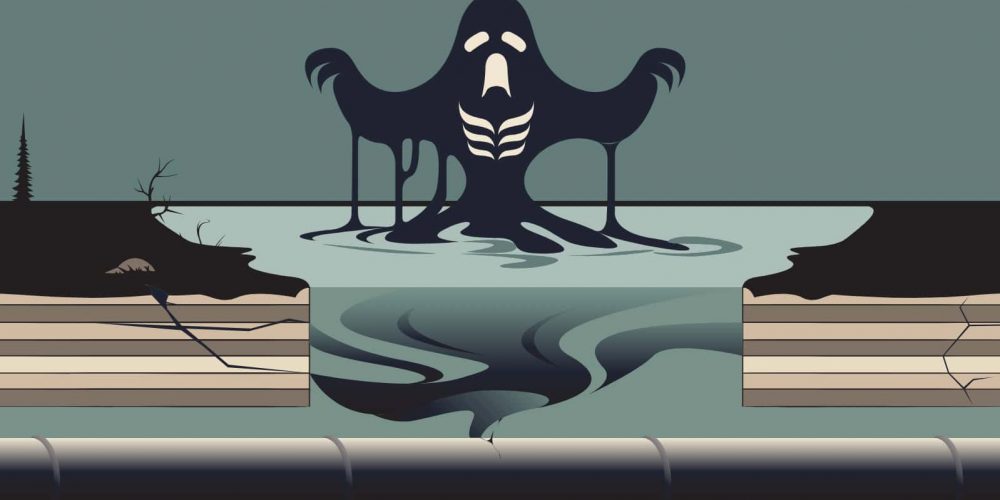
This resource compiles questions from the Yellowhead Institute Buried Burdens: The True Costs of Liquified Natural Gas (LNG) Ownership webinar held on October 29, 2025. Hosted by co-authors of the report, Janna Wale (Gitanmaax First Nation, Cree Métis) and Michaela McGuire (Haida Nation), the session featured community insight and commentary from Kolin Sutherland-Wilson (Gitxsan, Fireweed Clan), Tara Marsden Naxginkw, Gitanyow, Lax Ganeda (Frog Clan), Janelle Lapointe (Stellat’en First Nation), and Rosanna Carver (report co-author).
Developed alongside the Buried Burdens Yellowhead Institute Special Report, these FAQs highlight key themes, responses, and context shared during the discussion. It is intended as a resource for communities, researchers, and organizers navigating their responses to LNG development.
Some questions have been condensed and grouped for clarity.
HOSTS

Janna Wale
Gitanmaax First Nation, Cree Métis

Michaela McGuire
Haida Nation
PANELISTS

Tara Marsden
Naxginkw, Gitanyow, Lax Ganeda (Frog Clan)

Janelle Lapointe
Stellat'en First Nation

Kolin Sutherland-Wilson
Gitxsan, Fireweed Clan

Rosanna Carver
United Kingdom
Kolin: The core issue is that as long as Indigenous title remains unresolved, major projects will continue to create conflict. We’ve seen repeatedly in B.C. that consultation is vague at best and true consent is absent. Despite new legislation that claims to advance Indigenous rights, the standard for consent keeps being pushed further away. With Coastal GasLink, hereditary chiefs refused the project — and yet the province and company simply turned to band councils to sign agreements. We’ve now seen this play out in different directions across territories, creating confusion and division.
Until title is fully recognized and our jurisdiction is secured, every project puts our land and authority at risk.
Without that foundation, industry and government will continue operating in ways that undermine our inherent rights, increasing conflict and eroding our ability to steward our territories for future generations.
Tara: There are the direct environmental and climate risks — impacts to water, land, and emissions that the LNG industry continues to downplay. Claims of “net‐zero LNG” simply aren’t supported by the evidence. When you factor in electrification projects, land clearing for transmission lines, right-of-way clearing, slash burning, and potential gas burning if electricity isn’t secured, emissions are significant and unaccounted for. There are also financial risks.
There is a narrative that equity participation means economic development, jobs, and long-term community benefits. But most Indigenous Nations are not investing cash — they’re taking on debt.
This is particularly concerning in a volatile market where LNG prices are uncertain and a global supply glut is emerging.
This resembles predatory lending — targeting Nations that are economically vulnerable and have limited experience in these sectors. There is no guarantee these investments will pay off, and we have already seen Nations take on massive loans, like the $1.4 billion for a majority stake in Cedar LNG, with leaders acknowledging it could be a decade before any profits, and only if market conditions are ideal. We have to question why companies eager to “share” equity would offload profitable projects — it suggests they may not be as sound as advertised.
Janelle: My concern is that Coastal GasLink may be viewed as a successful model for future projects — despite the harm it caused. We saw militarized police action and surveillance against Nations that said no.
It can happen where a Nation signs on because leadership felt they had no real choice — if they didn’t sign, it would happen without us, and we’d lose any benefit. We were promised jobs and safe, cutting-edge construction. Instead, community members quietly told me about environmental harm: working in wet seasons when forestry couldn’t operate, collapsing riverbanks, dumping waste into our lake and denying it until caught. Jobs were few, temporary, and often low-paying, with racism on worksites. Safety in our own community changed; we saw increased fears around man camps. Promises of restoration, like berry patches for Elders, never materialized — those areas are now dead zones, and irreplaceable old growth was cut.
If this is how Nations that say “yes” are treated — lied to, harmed, and dismissed — it sets a dangerous precedent. It shows the risks aren’t just for those who oppose, but also for those trying to participate in good faith.
Rosanna: Equity ownership — often framed as co-ownership — means Nations buy shares in a project and share profits, but also share the risks and potential losses. Equity returns are not guaranteed; they only come after debt is repaid and only if the project becomes profitable.
Large-scale resource projects are exposed to many risks over long timeframes: cost overruns, delays, rising labour and material costs, environmental damage, and community opposition. Internally, costs can escalate at any stage — construction, operations, or decommissioning. Externally, markets shift, governments change policies, and climate-driven events, like floods or storms, add further uncertainty.
Equity agreements can also be used to bypass deeper structural questions — including who has authority, how decisions are made, and what other governance or economic models could better serve Nations. Before entering these arrangements, we need to fully assess the financial, environmental, and political risks, because the stakes are high and the outcomes are uncertain.
Kolin: One of the clearest tactics is the strategic use of money. Equity offerings and “partnership” funding become tools to draw Nations into projects, but ultimately function as subsidies for industry, backed by public dollars.
The Crown keeps decision-making power ambiguous — who gets to decide, who can sign, who the government recognizes — and once an environmental assessment certificate is issued, everything else becomes secondary. Even when Nations pursue judicial reviews, injunctions, or raise constitutional issues about Indigenous governance, the courts often refuse to revisit the original approval.
We saw this with Coastal GasLink and the Prince Rupert Gas Transmission pipeline (PRGT): decisions made quietly years ago bind us now, even though the project details have changed substantially. With unresolved title and unclear recognition of who speaks for the Nation and industry, the province can continue using our own governance structures against us. Uncertainty is the strategy.
Tara: When governments are challenged about a lack of consent, they point to the Nations that signed on and say, “Talk to them.” If a project harms the land or communities, Nations are told to “wear it.” But if there’s good news — jobs, investments — the province takes the credit.
This is a deliberate strategy to shift political, financial, and moral risk onto small Nations that are simply trying to support their people. The narrative is: we can’t reject fossil fuels because Indigenous communities need economic reconciliation. It’s not genuine reconciliation — it’s downloading responsibility and shielding the state and corporations from accountability.
Janelle: These fossil fuel companies are among the most powerful in the world, and their strongest tools are PR and misinformation. They knew about the climate crisis decades ago and hid it. Now we see similar tactics with LNG: downplaying health and environmental impacts, and even claiming LNG is “good” for the climate.
Processes that should provide oversight are weakened or rushed. Some projects move forward on expired environmental assessments. Others rely on assessments that were never Indigenous-led and don’t reflect our knowledge or priorities.
Communities aren’t getting accurate, independent information — they’re getting the industry’s marketing pitch.
Rosanna: Another colonial strategy at play is the way space — especially ocean space — is imagined and regulated. There’s a persistent colonial idea that marine areas are empty of Indigenous rights and title. Companies are increasingly turning to ocean-based infrastructure, like floating LNG platforms, because they believe it helps sidestep land-based jurisdiction and resistance. It reflects a broader pattern: when resistance to land-based projects strengthens, industry shifts tactics instead of addressing the underlying issues of Indigenous sovereignty and consent.
Kolin: It’s not difficult to imagine a sustainable economy when we recognize the wealth already inherent in our lands. In our territories — Gitxsan and Wet’suwet’en together — we have nearly 40,000 square kilometres of land and a relatively small population. Many nations around the world would envy that ratio of people to land and resources.
We have clean water, healthy forests, rich wildlife, medicines, berries, fish, and all the non-timber forest products that have sustained us for millennia. Our territories are the size of a small country — this is not about managing a tiny reserve, but stewarding vast lands that have always been ours.
If we remove colonial limits on our imagination, it becomes clear that we can thrive economically in ways that honour our land, people, and laws. There is no question that we can sustain ourselves and build futures rooted in who we are.
Tara: There’s a misconception that because we oppose LNG, we oppose economic development — that couldn’t be further from the truth. Since LNG projects were first proposed a decade ago, our Nation has continued to build a healthy, diverse economy without relying on those projects. And the sky didn’t fall because we said no.
What matters is scale, pace, and alignment with our laws and values. Development must follow our vision, not overwhelm it. As some of our relatives say, “One mine at a time.”
We don’t need ten megaprojects pushed at us simultaneously. We can pursue sustainable forestry, tourism, mining, fisheries, and conservation-based economies on our terms.
We are already practicing sustainable, self-determined development — and we should continue saying no to projects that don’t fit our vision.
Kolin: We need to take inventory of what we have. Because we’re wealthy; we’re talented; we’re not lesser than any other demographic! As we shed colonial trauma, we can build something beautiful and unprecedented, grounded in the values handed down by our ancestors and our arts.
We don’t need to buy into the Canadian economic vision — we’ve seen how it works: a large extraction machine that sees our lands as numbers and profit. For us, this is home and has been for millennia. We can’t poison water, destroy what sustains us, and then move on.
Whatever we build must be rooted in long-term values. The Canadian project is young and unstable; states can collapse quickly. We, however, will still be here. Long-term thinking is our greatest asset. So we continue doing the work, and these extractive propositions will eventually fall away, while we remain.
Tara: Sharing information is essential. We need the most up-to-date science, economics, knowledge of Indigenous laws and what other Nations are doing. This work affects many people; our decisions ripple across Nations.
We must stay connected to stay open-hearted. Some Nations have signed agreements; they are not our enemies. They may come to realize the true impacts later. We must give them an off-ramp — a place to return without judgment. We are already seeing cracks: health impacts, people questioning what they agreed to. People will come around, and hopefully it won’t be too late for our land, water, and climate.
Rosanna: These moments present opportunities. The report highlights that uncertainty in the legal landscape is a chance to assert Indigenous laws and interpretations.
Ocean space is a key example: the Crown recognizes some rights, mostly tied to activities like fishing, but continues to limit Indigenous governance over ocean territories. Nations along the coast are advancing title cases and legal strategies to assert Indigenous jurisdiction in these spaces, which will be a powerful tool for challenging encroachment and reshaping the legal terrain on Indigenous terms.
Janelle: I’m inspired by the Lax’yip Firekeepers — they’re showing what resistance can look like: not just reacting, but building deep relationships with land and community. Learning plants and fungi, creating space for youth, strengthening bonds — that’s resistance.
It’s about falling back in love with land and each other, rebuilding confidence, shedding colonial trauma, and knowing we are powerful and knowledgeable. That alone disrupts the narrative that extractivism is our only option.
We don’t have to burn out or turn on one another. We don’t have to fall for divide-and-conquer strategies. We can reclaim our power, traditions, and creativity.
Janna and Michaela: Electrification is being marketed as a “clean energy” solution that powers LNG facilities with electricity rather than fossil fuels. But LNG remains a fossil fuel industry, and electrifying it dramatically increases energy and resource demand. Powering the LNG build-out would require electricity equivalent to 8.4 Site C dams — another deeply contested project that has flooded Indigenous lands and violated rights.
Under B.C. ‘s Bill 14, fast-tracked renewable energy projects can be used to power fossil fuel extraction, meaning “clean energy” development is being used to expand the very industry driving climate breakdown. This approach also intensifies pressure for mining and new transmission lines on Indigenous territories, expanding extractive footprints rather than reducing them. Rather than a climate solution, electrification risks deepening environmental damage and colonial control through green-washed development.
A: Cumulative impacts — the total effects of development over time — are largely ignored in current project reviews, despite them being the most devastating. LNG infrastructure fragments ecosystems, harms marine life, increases greenhouse gas emissions, and undermines food security, especially for salmon-dependent Nations.
Social impacts are just as significant: increased cost of living in boom-town regions, housing strain, heightened violence and safety risks for Indigenous women and girls from work camps, and the fracturing of community relationships when Nations are pressured to take opposing positions. These cumulative harms threaten governance, cultural continuity, and the ability of communities to live well on their homelands.
Ultimately, the LNG industry undermines Indigenous worldviews centred on caretaking, kinship, and interdependence, replacing them with short-term economic calculus and long-term instability.
Tara: IBAs are private, confidential, contractual agreements that exchange consent and silence for financial benefits. Consent as a legal requirement under UNDRIP should be the result of transparent processes, not confidential agreements behind closed doors.
For many, IBAs are the only way to secure any benefits from a project. Companies can be very aggressive in negotiations, and very restrictive in what they will agree to. Once a project has received its approvals and permits, the negotiating leverage for the nations goes down significantly.
Rosanna: PRGT will be equity returns-based which, unlike IBAs, are not fixed payments. IBAs are essentially private contracts proposed to manage the effects of projects. They are a way for industry to gain a social licence to operate. IBAs often focus predominantly on economic benefits — such as Employment and training — which are claimed to mitigate the negative impacts of a project. Social, cultural, environmental impacts, etcetera, are often overlooked.
Kolin: The Impact Benefit Agreements signed between industry proponents and Indigenous communities are almost always confidential. That secrecy means there is little to no meaningful community oversight over how funds are negotiated, received, or distributed. Typically, IBAs provide staged payments: an initial “signing bonus,” followed by further installments tied to particular project milestones. But because these agreements are not publicly available, communities cannot verify how much money is actually received, how it is used, or whether the commitments were honoured.
Implementation varies depending on a community’s governance structure, but the lack of transparency creates predictable vulnerabilities. With the PRGT IBAs, for example, there were no safeguards preventing funds from flowing directly to individual signatories without broader Wilp-level consent or accountability. In band council contexts, the Indian Act provides almost no legislative protections against conflicts of interest, increases to honoraria, or private dealings between council members and industry. Employment by the same company that a council is negotiating with is not meaningfully regulated.
Any serious assessment of whether IBAs adequately protect against risks is impossible without access to the agreements themselves. This opacity is not accidental. The core function of an IBA is to secure consent or acquiescence in exchange for payments that, in effect, limit the proponent’s liability for the environmental, health, safety, and rights-based harms the project may cause. The idea that these funds represent “benefits” rather than compensation obscures the fact that there is always an exchange, even when the bargaining power is structurally unequal or coercive.
Many signatories have described industry negotiations in exactly those terms: “It’s going to happen whether you sign or not, so you might as well get something,” or “If we don’t sign, they’ll just build it anyway and send in the army like they did with the Wet’suwet’en.” That kind of pressure is not free, informed consent; it is a manufactured inevitability.
Fundamentally, the IBA process is as unregulated as the pipelines themselves. Without transparency, enforceable standards, or community-level oversight, there is no credible way to claim that IBAs adequately mitigate risk.
Kolin: The implementation of UNDRIP in Canada has shown that it functions much like the legal concept of Aboriginal Title: it looks promising on the surface, but in practice, it becomes a mechanism that limits rather than strengthens Indigenous authority. Both end up defining Indigenous rights as inherently infringeable. Governments and courts routinely dismiss the UNDRIP articles that would meaningfully protect Indigenous peoples as merely “aspirational” or non-binding, while selectively embracing the parts that help create predictable, state-managed processes for infringement.
Instead of reinforcing the autonomy and legal orders of distinct Indigenous nations, UNDRIP-derived legislation, such as DRIPA and post-DRIPA policies like Bill-14 (BC), Bill-15 (BC), and Bill C-5 (Canada), continues to pull those diverse systems into a single, nationalized framework. This homogenization mirrors the original purpose of the Indian Act: to standardize and domesticate Indigenous governance so that it can be more easily administered, contained, and overridden by the state.
Indigenous laws, languages, and governance structures exist at the level of individual nations, Huwilp, and communities, each with its own protocols and legitimacy. These systems are inherently diverse, place-based, and relational; that complexity makes them fundamentally incompatible with Canada’s desire for uniformity. When the state codifies Indigenous rights at a national scale, it flattens that diversity into something legible to Canada, not something accountable to the peoples who actually hold those laws.
So while UNDRIP may offer symbolic leverage and pathways towards restitution, its current implementation does not hold governments to account. It creates a standardized path for governments to manage and justify infringements, rather than recognizing the authority of Indigenous legal orders on their own terms.
If there is any hope at all, it depends on reclaiming real political authority and jurisdictional autonomy, because UNDRIP can only function as a tool in the hands of Indigenous peoples who have the power to enforce it. As long as we remain submerged within Canada’s legal and political hierarchy, UNDRIP will never operate as anything more than empty promises on paper (a proud Canadian tradition).
LEARN MORE
As federal and provincial governments pass legislation to fast track resource development, the contentious Prince Rupert Gas Transmission Project (PRGT) has been approved while the Ksi Lisims facility has been designated a “national interest” project. This LNG infrastructure is expected to transport and export millions of tonnes of fracked gas annually, making it one of the country’s largest LNG projects. To learn more about the project and its risks and potential impacts, read the Yellowhead Special Report, Buried Burdens: The True Costs of Liquified Natural Gas (LNG) Ownership.
